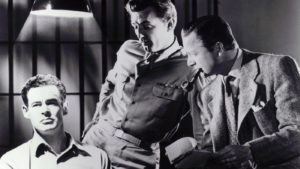The challenge of finding subtext in interrogations
09 Friday Feb 2018
Unusual dialogue: subtext in interrogations:
I’ve written a number of articles on dialogue and subtext but this week playwright Sarah Hamilton came up with a problem about subtext in interrogations that I’d not covered before.
Sarah posted this question in the comments section under my article “9 steps to writing dialogue with rich subtext”
Thanks for the post. Can you still incorporate subtext in something like an interrogation scene when one character has to be on the nose to ask the
questions – that’s their job e.g. a police officer – but the other character doesn’t have the answers?
I think subtext would be easier if the other character, for example, the suspect DID have the answers and wasn’t saying but is harder if the suspect is ‘innocent’? How can one introduce subtext here?
Charles says:
Yes, absolutely you can find subtext in interrogations – and must.
The interrogator will definitely have things that they aren’t saying. For example, they may feel insecure, or angry, but try to remain overtly in control and polite. They may feel they don’t have as much leverage as they’d like. Or be trying to hide their growing frustration.
An innocent suspect will also have subtext, even if they are telling the truth, because there will always be things they aren’t saying. They may have other matters to hide, for example. Or they may have other issues that they’re concealing, such as (again) anger, insecurity, pride.
Concealing their true feelings
Did they know the victim and want to seem as if they had a better relationship than they did? Are they impatient to be finished and leave, but feel that to reveal this would make them look bad?
Or are they getting their rocks off by being “helpful” to the police, trying to conceal their excitement at being at the heart of a big investigation…. I’m sure you can think of more, and better, ideas.
Revealing new information
Sarah then expanded more on the story, explaining that there was in fact crucial information that the suspect didn’t know. This information was going to be revealed to him during the interrogation.
She added: The tip about the interrogator also having things to hide is one I hadn’t really thought of before so thanks. My scene is a little less straightforward than a policeman questioning a suspect tho.
To try and be as brief as possible, it involves a character who is being interrogated as to [a crucial fact that] not even he knew he had so he can’t choose to be truthful or lie to the interrogator because it’s news to him too.
However, [others] want a piece of it too.
I suppose even though the protagonist is under threat… subtext can come from his strategic way of handling the situation?
Charles says: The protagonist, of course, would have quite a conflict going on inside, not all of which he’d want to be seen. If only for reasons of self-esteem. Having just discovered this new crucial fact, he would presumably be in inner turmoil.
On a personal level, there will be doubts and fears – as well as pride – which he’ll be trying to control while attempting to put on a “face”.
This face will depend on how he generally likes to be perceived. For example, he want to look calm and unruffled.
Imagine a scene in which a teenager is being questioned by one of her teachers. The teacher accuses her of cheating in order to get full marks in a test, but the student didn’t know until then that she had done so.
She’ll feel a mixture of pride and fear, as well as doubt (has someone added up the marks wrongly?) But, feeling vulnerable, she may hide her true feelings and put on an air of detachment or disdain.
Many opportunities for subtext in interrogations
Then there are outer story reasons for your protagonist to hold back.
Does he know, or suspect, that other characters want a share of what he has just learned about? If so, he’ll be motivated to conceal any additional information he may realise he has. Indeed, he may not know the full truth himself, and desperately want time alone to discover more.
In such a situation, he could be covertly manipulating his answers to see if he can get his interrogator to give information away.
Suppose the interrogator had just revealed that a painting your hero owns is a lost Rembrandt. As he speaks, he’s trying to remember where he put it. Perhaps there’s a matching pair somewhere. Can he get the interrogator to drop hints as to where the other painting is being kept?
Subtext is often unconscious
Finally, he may be in denial. We often think of subtext as being deliberate but often the audience can see what a character is still unconscious of. Anything that involves the audience or reader seeing something below the surface is subtext.
So, for example, we may see that a man hasn’t got over his divorce, even though he protests – and truly believes – that he has.
The interrogator too
And of course the interrogator has his own issues. At the start of the scene, he knows something the protagonist doesn’t. How does he play it? At what point does the audience realise – before the scene starts, during the scene but before the interrogator reveals what he knows? Later?
The interrogator will want to hold some information back, if only to stay in the driving seat.
So, you have a wealth of opportunities for subtext here, making the scene very rich, interesting and alive.
Recommended reading:
If you found this useful, I have more articles on dialogue writing.
I also recommend articles by the Writers Workshop and The Balance
One of the best books on writing fiction dialogue is Dialogue by Gloria Kempton – UK USA
And of course there are the extensive sections on dialogue in my own Teach Yourself: Complete Screenwriting Course – UK USA
Sarah Hamilton has an interesting blog of her own – Writerly
And if you have any questions of your own, please send them to my “Say Hi or Ask A Question” page and I’ll see what I can do.


Tell people what you think